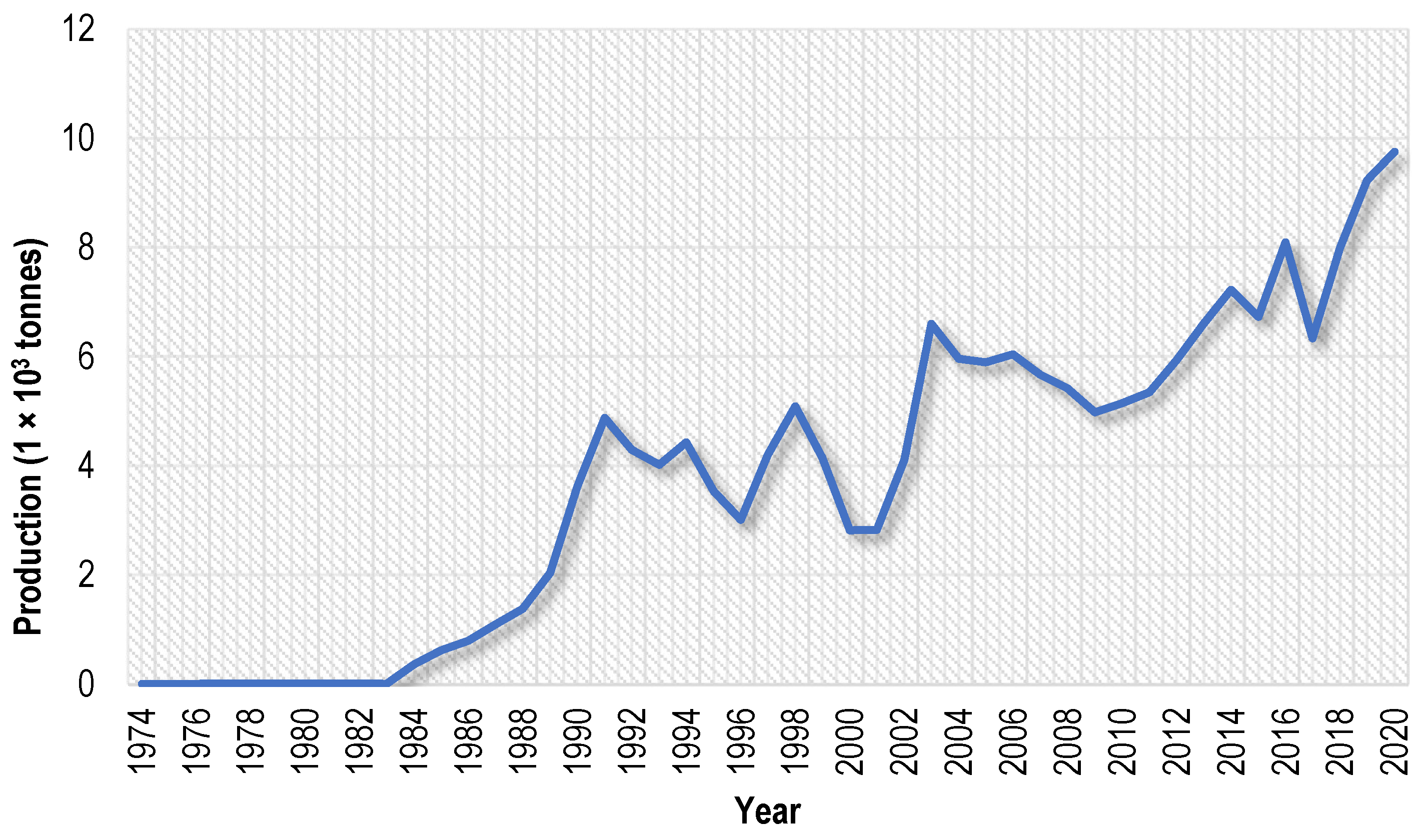Aquaculture Production in the Midst of GHG Emissions in South Africa
Abstract
1. Introduction
2. Material and Methods
2.1. Conceptual Framework
2.2. Study Design
3. Results
3.1. Descriptive Statistics
3.2. Empirical Results
4. Discussion
5. Conclusions
Author Contributions
Funding
Institutional Review Board Statement
Informed Consent Statement
Data Availability Statement
Conflicts of Interest
References
- World Bank. Priorities for Sustainably Managing Sri Lanka’s Marine Fisheries, Coastal Aquaculture, and the Ecosystems That Support Them; World Bank: Washington, DC, USA, 2021. [Google Scholar]
- FAO. Statistical Yearbook: World Food and Agriculture; Food and Agriculture Organization: Rome, Italy, 2021; ISBN 9789251343326. [Google Scholar]
- Adeleke, B.; Robertson-andersson, D.; Moodley, G.; Adeleke, B.; Robertson-andersson, D.; Moodley, G. Aquaculture in Africa: A comparative review of Egypt, Nigeria and Uganda vis-a-vis South Africa. Rev. Fish. Sci. Aquac. 2021, 29, 167–197. [Google Scholar] [CrossRef]
- PMG Commercial fishing organisations: Fish SA.; WWF & AquaCulture. 2020. Available online: https://pmg.org.za/committee-meeting/30478/ (accessed on 1 February 2022).
- SADC-EU EPA South African Fisheries and the SADC-EU Economic Partnership Agreement. 2017. Available online: https://sadc-epa-outreach.com/images/files/sadc-eu-epa-fisheries-july-2017.pdf (accessed on 3 February 2022).
- AgriSETA. Aquaculture Sub-Sector Skills Plan (2020–2021); AgriSETA: Arcadia, Pretoria, 2019; Available online: https://www.agriseta.co.za/wp-content/uploads/2021/02/Agriseta_Aquaculture_SSSP_DIGITAL.pdf (accessed on 7 December 2021).
- WWF-SA. Fisheries: Facts and trends South Africa; WWF-SA: Cape Town, South Africa, 2011; Available online: http://awsassets.wwf.org.za/downloads/wwf_a4_fish_facts_report_lr.pdf (accessed on 8 August 2021).
- World Bank Aquaculture Production (Metric Tons)-South Africa. 2021. Available online: https://data.worldbank.org/indicator/ER.FSH.AQUA.MT?locations=ZA (accessed on 17 March 2023).
- DEFF. Operation Phakisa: Unlocking the Oceans Economy through Aquaculture; DEFF: Pretoria, South Africa, 2019. Available online: https://www.dffe.gov.za/sites/default/files/docs/publications/operation_phakisa_yearfive.pdf (accessed on 2 January 2022).
- Fish SA. Fishing for a Sustainable and Equitable Future; Fish SA: Cape Town, South Africa, 2019. [Google Scholar]
- Friedrich, E.; Trois, C. Current and future greenhouse gas (GHG) emissions from the management of municipal solid waste in the eThekwini Municipality—South Africa. J. Clean. Prod. 2016, 112, 4071–4083. [Google Scholar] [CrossRef]
- Gerber, P.J.; Steinfeld, H.; Henderson, B.; Mottet, A.; Opio, C.; Dijkman, J.; Falcucci, A.; Tempio, G. Tackling climate change through livestock: A global assessment of emissions and mitigation opportunities. In Tackling Climate Change Through Livestock: A Global Assessment of Emissions and Mitigation Opportunities; Gerber, P.J., Steinfeld, H., Henderson, B., Mottet, A., Opio, C., Dijkman, J., Falcucci, A., Tempio, G., Eds.; Food and Agriculture Organization: Rome, Italy, 2013; Available online: http://www.fao.org/docrep/018/i3437e/i3437e00.htm (accessed on 3 October 2022).
- Macleod, M.J.; Hasan, M.R.; Robb, D.H.F. Quantifying greenhouse gas emissions from global aquaculture. Sci. Rep. 2020, 10, 11679. [Google Scholar] [CrossRef] [PubMed]
- Ahmed, N.; Thompson, S.; Glaser, M. Global aquaculture productivity, environmental sustainability, and climate change adaptability. Environ. Manage. 2019, 63, 159–172. [Google Scholar] [CrossRef] [PubMed]
- Raul, C.; Pattanaik, S.S.; Prakash, S.; Sreedharan, K.; Bharti, S. Greenhouse Gas Emissions from Aquaculture Systems. World Aquac. 2020, 57, 57–61. [Google Scholar]
- Subasinghe, R.P.; Delamare-Deboutteville, J.; Mohan, C.V.; Phillips, M.J. Vulnerabilities in aquatic animal production. Rev. Sci. Tech. 2019, 38, 423–436. [Google Scholar] [CrossRef] [PubMed]
- Barange, M.; Cochrane, K.L. Impacts of climate change on fisheries and aquaculture: Conclusions. In Impacts of Climate Change on Fisheries and Aquaculture: Synthesis of Current Knowledge, Adaptation and Mitigation Options; Barange, M., Bahri, T., Beveridge, M.C.M., Cochrane, K.L., Funge-Smith, S., Poulain, F., Eds.; Food and Agriculture Organization: Rome, Italy, 2018; ISBN 978-92-5-130607-9. [Google Scholar]
- Adhikari, S.; Cahudhari, A.; Barlaya, G.; Rathod, R.; Mandal, R.N.; Ikmail, S.; Saha, G.S.; De, H.; Iyemperumal, S.; Mahapatra, A.S.; et al. Adaptation and Mitigation Strategies of Climate Change Impact in Freshwater Aquaculture in some states of India. J. Fish. 2018, 12, 16–21. [Google Scholar] [CrossRef]
- Barange, M.; Bahri, T.; Beveridge, M.C.M.; Cochrane, K.L.; Funge-Smith, S.; Poulain, F. (Eds.) Impacts of Climate Change on Fisheries and Aquaculture; Food and Agriculture Organization: Rome, Italy, 2018; ISBN 9789251306079. [Google Scholar]
- Liddle, B. Environmental Modelling & Software Population, affluence, and environmental impact across development: Evidence from panel cointegration modeling q. Environ. Model. Softw. 2013, 40, 255–266. [Google Scholar] [CrossRef]
- Robb, D.H.F.; Macleod, M.J.; Hasan, M.R.; Soto, D. Greenhouse Gas Emissions from Aquaculture: A Lifecycle Assessment of Three Asian Systems; FAO: Rome, Italy, 2017. [Google Scholar]
- Hammer, A.J.; Millar, C.; Hennige, S.J. Reducing carbon emissions in aquaculture: Using Carbon Disclosures to identify unbalanced mitigation strategies. Environ. Impact Assess. Rev. 2022, 96, 106816. [Google Scholar] [CrossRef]
- Xu, C.; Su, G.; Zhao, K.; Xu, X.; Li, Z.; Hu, Q.; Xue, Y.; Xu, J. Current status of greenhouse gas emissions from aquaculture in China. Water Biol. Secur. 2022, 1, 100041. [Google Scholar] [CrossRef]
- Kosten, S.; Almeida, R.M.; Barbosa, I.; Mendonça, R.; Santos Muzitano, I.; Sobreira Oliveira-Junior, E.; Vroom, R.J.E.; Wang, H.J.; Barros, N. Better assessments of greenhouse gas emissions from global fish ponds needed to adequately evaluate aquaculture footprint. Sci. Total Environ. 2020, 748, 141247. [Google Scholar] [CrossRef]
- Rasenberg, M.; Poelman, M.; Smith, S.; Hoof, L. Van GHG Emissions in Aquatic Production Systems and Marine Fisheries; IMARES: Wageningen, the Netherlands, 2013. [Google Scholar]
- de Sousa-Neto, E.R.; Gomes, L.; Nascimento, N.; Pacheco, F.; Ometto, J.P. Land Use and Land Cover Transition in Brazil and Their Effects on Greenhouse Gas Emissions; Academic Press: Cambridge, MA, USA, 2018; pp. 309–321. [Google Scholar] [CrossRef]
- DAFF. Integrated Growth and Development Plan; DAFF: Pretoria, South Africa, 2012. [Google Scholar]
- Mujuru, M.; Dube, T.; Mabizela, H.; Ntuli, N. Evaluating greenhouse gas emission reductions by using solar water heaters: A case of low income households in Ekurhuleni, South Africa. Phys. Chem. Earth Parts A/B/C 2020, 116, 102843. [Google Scholar] [CrossRef]
- Ortega-cisneros, K.; Cochrane, K.L.; Rivers, N.; Sauer, W.H.H.; Rice, J.; Ortega-cisneros, K. Assessing South Africa’s potential to address climate change impacts and adaptation in the fisheries sector. Front. Mar. Sci. 2021, 8, 652955. [Google Scholar] [CrossRef]
- Jiang, Q.; Bhattarai, N.; Pahlow, M.; Xu, Z. Environmental sustainability and footprints of global aquaculture. Resour. Conserv. Recycl. 2022, 180, 106183. [Google Scholar] [CrossRef]
- Mayers, J.; Batchelor, C.; Bond, I.; Hope, R.; Morrison, E.; Wheeler, B. Water Ecosystem Services and Poverty under Climate Change: Key Issues and Research Priorities; Natural Resources Issues No. 17; International Institute for Environment and Development (UK): London, UK, 2009; ISBN 9781843696872. Available online: http://pubs.iied.org/13549IIED.html (accessed on 2 December 2021).
- Ngarava, S. Relationship between economic diversification and CO2 emissions: ARDL-EC modeling in South Africa ARDL-EC modeling in South Africa. Dev. Stud. Res. 2021, 8, 264–279. [Google Scholar] [CrossRef]
- Coulibaly, G.R.; Akia, S.A. Export structure and economic growth in a developing country: Case of Cote d’Ivoire. Munich Pers. RePEc Arch. 2017. Available online: https://mpra.ub.uni-muenchen.de/id/eprint/91374 (accessed on 2 March 2023).
- Kohler, M. CO2 emissions, energy consumption, income and foreign trade: A South African perspective. Energy Policy 2013, 63, 1042–1050. [Google Scholar] [CrossRef]
- Adeleye, N. Autoregressive Distributed Lag (ARDL): Specification. 2018. Available online: http://cruncheconometrix.org.ng (accessed on 8 July 2021).
- Ritchie, H.; Roser, M.; CO2 and greenhouse gas emissions. Our World Data. 2020. Available online: https://ourworldindata.org/co2-and-other-greenhouse-gas-emissions (accessed on 8 January 2021).
- World Bank World Development Indicators: Aquaculture Production (Metric Tonnes). 2022. Available online: https://databank.worldbank.org/source/world-development-indicators# (accessed on 8 January 2021).
- Quantec Easydata Production and Consumption of Beef and Veal: Total Production. Available online: https://www.easydata.co.za/dataset/AGR/timeseries/AGR-T060S001/ (accessed on 8 January 2021).
- Odhiambo, N.M. Economic growth and carbon emissions in South Africa: An empirical investigation. J. Appl. Bus. Res. 2012, 28, 75–84. [Google Scholar]
- DAFF. Aquaculture yearbook 2016 South Africa, Pretoria, South Africa. 2016. Available online: https://www.nda.agric.za/doaDev/sideMenu/fisheries/03_areasofwork/Aquaculture/AquaDocumentation/DAFF %0AYearbook 2016.5Mb.pdf (accessed on 3 October 2022).
- Britz, P.J.; Venter, S. Aquaculture review: South Africa. World Aquac. 2016, 47, 19–28. [Google Scholar]
- Mahlalela, P.T.; Blamey, R.C.; Hart, N.C.G.; Reason, C.J.C. Drought in the Eastern Cape region of South Africa and trends in rainfall characteristics. Clim. Dyn. 2020, 55, 2743–2759. [Google Scholar] [CrossRef]
- World Bank. Climate Change Knowledge Portal: South Africa. 2022. Available online: https://climateknowledgeportal.worldbank.org/country/south-africa/climate-data-historical#:~:text=South Africa is highly vulnerable,fed agriculture and natural resources.&text=Mean annual temperature for South,C(June%2C July) (accessed on 15 February 2022).
- Britz, P.J. A study on the status of aquaculture production and trade in South Africa. Enviro-Fish Africa 2007, 2, 24.
- USAID. Greenhouse Gas Emissions in South Africa; USAID: Washington, DC, USA, 2014. [Google Scholar]
- DEA. Greenhouse Gas Inventory for South Africa: 1990–2000; DEA: Pretoria, South Africa, 2009; Available online: https://static.pmg.org.za/docs/090812greenhouseinventory.pdf (accessed on 18 July 2021).
- DEA. GHG National Inventory Report: South Africa (2000–2015); DEA: Pretoria, South Africa, 2015; Available online: https://unfccc.int/sites/default/files/resource/South Africa NIR 2017.pdf (accessed on 7 April 2021).
- Smith T South Africa’s Greenhouse Gas Emissions on the Rise, Says Report. 2021. Available online: https://www.esi-africa.com/industry-sectors/finance-and-policy/south-africas-greenhouse-gas-emissions-on-the-rise-says-report/#:~:text=Greenhouse gas emissions in South,10.4%25 between 2000 and 2017.&text=There was an annual average,Environment on Tuesday (accessed on 19 February 2022).
- World Bank. GDP (current US$)—Sub Saharan Africa. 2022. Available online: https://data.worldbank.org/indicator/NY.GDP.MKTP.CD?locations=ZG (accessed on 20 January 2022).
- DEFFE. National GHG Inventory Report South Africa; DEFFE: Pretoria, South Africa, 2017. [Google Scholar]
- Africa Check South Africa the 12th Biggest Source of Greenhouse Gases? Yes, but That’s Not the Only Measure that Matters. 2021. Available online: https://www.polity.org.za/article/south-africa-the-12th-biggest-source-of-greenhouse-gases-yes-but-thats-not-the-only-measure-that-matters-2021-04-19#:~:text=Yes%2C but that’s not the only measure that matters,-19th April 2021&text=“South Africa is the wo (accessed on 17 February 2022).
- Khobai, H.; Roux, P. Le The Relationship between Energy Consumption, Economic Growth and Carbon Dioxide Emission: The Case of South Africa. Int. J. Energy Econ. Policy 2017, 7, 102–109. [Google Scholar]
- Adebayo, T.S.; Odugbesan, J.A. Modeling CO2 emissions in South Africa: Empirical evidence from ARDL based bounds and wavelet coherence techniques. Environ. Sci. Pollut. Res. 2021, 28, 9377–9389. [Google Scholar] [CrossRef] [PubMed]
- Ngarava, S.; Zhou, L.; Ayuk, J.; Tatsvarei, S. Achieving food security in a climate change environment: Considerations for Environmental Kuznets Curve use in the South African agricultural sector. Climate 2019, 7, 108. [Google Scholar] [CrossRef]
- Hughes, L.; Herian, A. The Correlation between GDP and Greenhouse Gas Emissions. 2017. Available online: https://policyoptions.irpp.org/magazines/september-2017/the-correlation-between-gdp-and-greenhouse-gas-emissions/ (accessed on 19 February 2022).
- Cederborg, A.J.; Snöbohm, S. Is There a Relationship between Economic Growth and Carbon Dioxide Emissions? 2016. Available online: https://www.diva-portal.org/smash/get/diva2:1076315/FULLTEXT01.pdf (accessed on 19 February 2022).
- Kurniawan, S.B.; Ahmad, A.; Rahim, N.F.M.; Said, N.S.M.; Alnawajha, M.M.; Imron, M.F.; Abdullah, S.R.S.; Othman, A.R.; Ismail, N.‘I.; Hasan, H.A. Aquaculture in Malaysia: Water-related environmental challenges and opportunities for cleaner production. Environ. Technol. Innov. 2021, 24, 101913. [Google Scholar] [CrossRef]
- Bjørndal, T.; Tusvik, A. Economic Analysis of the Contrinutions of Capture Fisheries and Aquaculture to Future Food Security; Centre for Applied Research at NHH: Bergen, Norway, 2020. [Google Scholar]
- Tran, N.; Shikuku, K.M.; Peart, J.; Chan, C.Y.; Chu, L.; Bailey, C.; Valdivia, R. A review of economic analysis of climate change impacts and adaptation in fisheries and aquaculture. SocArXiv Pap. 2021, 1–45. [Google Scholar] [CrossRef]
- van der Lingen, C.D. Adapting to climate change in the South African small pelagic fishery. In Adaptive Management of Fisheries in Response to Climate Change; Bahri, T., Vasconcellos, M., Welch, D., Johnson, J., Perry, I.R., Ma, X., Sharma, R., Eds.; Technical Paper No. 667; FAO Fisheries and Aquaculture: Rome, Italy, 2021; pp. 177–194. [Google Scholar]
- Cochrane, K.L.; Eggers, J.; Sauer, W.H.H. A diagnosis of the status and effectiveness of marine fisheries management in South Africa based on two representative case studies. Mar. Policy 2020, 112, 103774. [Google Scholar] [CrossRef]
- Cochrane, K.L.; Ortega-Cisneros, K.; Iitembu, J.A.; dos Santos, C.I.; Sauer, W.H.H. Application of a general methodology to understand vulnerability and adaptability of the fisheries for small pelagic species in the Benguela countries: Angola, Namibia and South Africa. Afr. J. Mar. Sci. 2020, 42, 473–493. [Google Scholar] [CrossRef]
- Bolton, J.J.; Anderson, R.J.; Smit, A.J.; Rothman, M.D. South African kelp moving eastwards: The discovery of Ecklonia Maxima (Osbeck) Papenfuss at De Hoop Nature Reserve on the South Coast of South Africa. Afr. J. Mar. Sci. 2012, 34, 147–151. [Google Scholar] [CrossRef]
- Barends-jones, V. Carbon Footprint Report: Departmental Research Farms (2019–2020); Western Cape Department of Agriculture Division for Macro & Resource Economics: Cape Town, South Africa, 2021; Available online: https://www.elsenburg.com/wp-content/uploads/2022/02/2021-Carbon-Footprint-Research-Farms-2019-20.pdf (accessed on 19 March 2023).
- Simdi, H.; Seker, A. A change is gonna come: Will traditional meat production end ? Environ. Sci. Pollut. Res. 2021, 29, 30470–30485. [Google Scholar] [CrossRef] [PubMed]
- Grossi, G.; Goglio, P.; Vitali, A.; Williams, A.G. Livestock and climate change: Impact of livestock on climate and mitigation strategies. Anim. Front. 2019, 9, 69–76. [Google Scholar] [CrossRef] [PubMed]
- Rojas-downing, M.M.; Nejadhashemi, A.P.; Harrigan, T.; Woznicki, S.A. Climate change and livestock: Impacts, adaptation and mitigation. Clim. Risk Manag. 2017, 16, 145–163. [Google Scholar] [CrossRef]
- MacLeod, M.; Hasan, M.; Robb, D.H.F.; Mamun-Ur-Rashid, M. Quantifying and Mitigating Greenhouse Gas Emissions from Global Aquaculture Quantifying and Mitigating; Technical Paper No. 626; FAO Fisheries and Aquaculture: Rome, Italy, 2019. [Google Scholar]
- Kristofersson, D.; Anderson, J.L. Is there a relationship between fisheries and farming? Interdependence of fisheries, animal production and aquaculture. Mar. Policy 2006, 30, 721–725. [Google Scholar] [CrossRef]
- Ngarava, S. Evaluating Livestock Development Programmes through the Production Risk Interface: Case of the Kaonafatso ya Dikgomo (KyD) Scheme in South Africa. Doctoral Thesis, University of Fort Hare, Alice, South Africa, 2019. [Google Scholar]
- Meissner, H.H.; Scholtz, M.M.; Palmer, A.R. Sustainability of the South African livestock sector towards 2050 Part 1: Worth and impact of the sector. S. Afr. J. Anim. Sci. 2013, 43, 282–297. [Google Scholar] [CrossRef]
- Meissner, H.H.; Scholtz, M.M.; Engelbrecht, F.A. Sustainability of the South African livestock sector towards 2050 part 2: Challenges, changes and required implementations. S. Afr. J. Anim. Sci. 2013, 43, 289–319. [Google Scholar] [CrossRef]

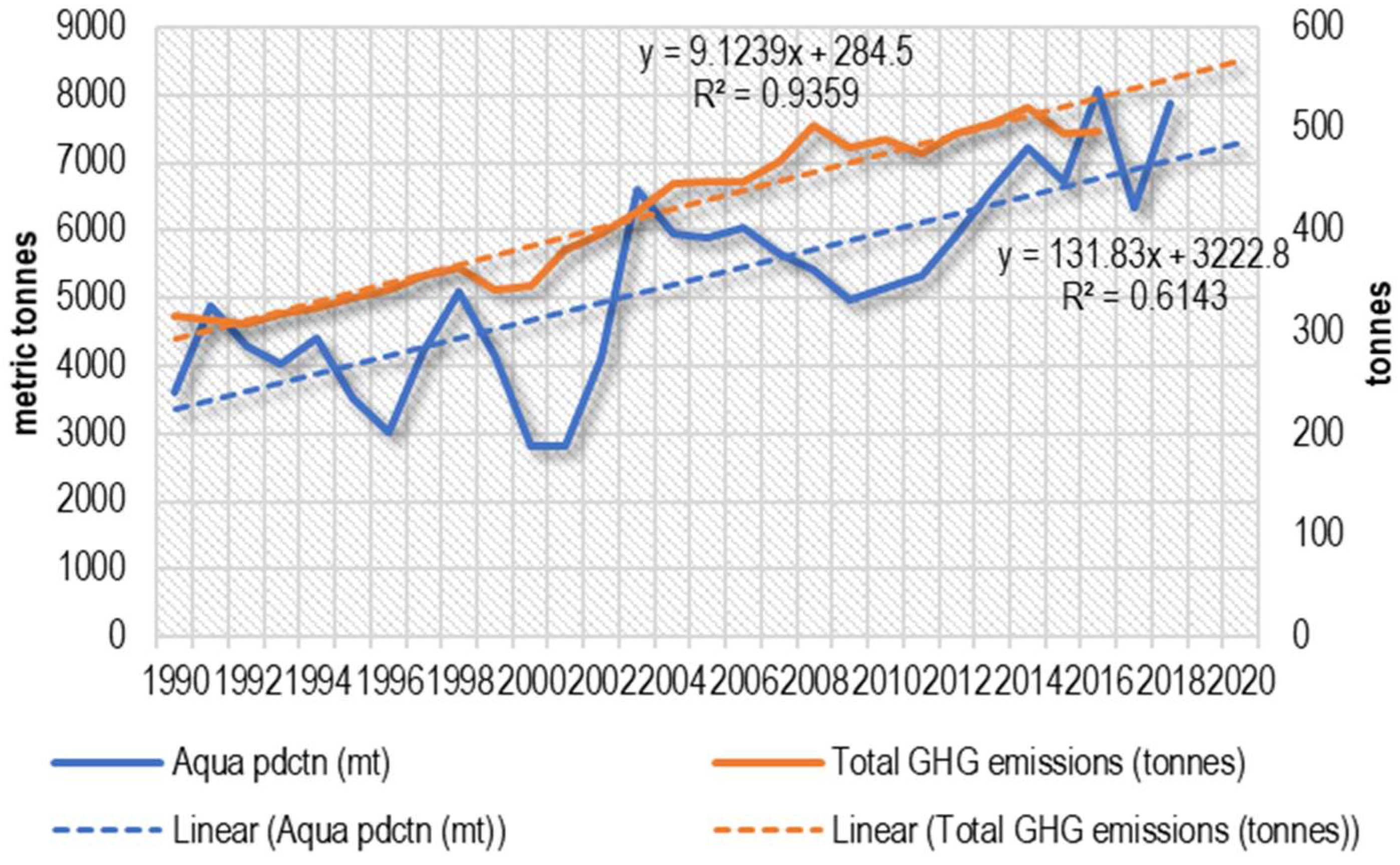
| Variable | Aquaculture Production (Metric Tonnes) | Beef Production (000 Tonnes) | Greenhouse Gas Emissions (Tonnes) | Gross Domestic Product (USD) (Million) |
|---|---|---|---|---|
| Mean | 5200.20 | 756.79 | 412.23 | 446,620 |
| Minimum | 2819.00 | 496.30 | 308.89 | 235,129 |
| Maximum | 8094.27 (2016) | 1090.90 | 520.54 | 673,272 |
| Std. Dev. | 1432.10 | 196.98 | 74.86 | 160,424 |
| Skewness | 0.152 | 0.274 | −0.040 | 0.116 |
| Kurtosis | −0.601 | −1.275 | −1.701 | −1.607 |
| Augmented Dickey Fuller (ADF) Test | Phillips–Perron (PP) Test | |||
|---|---|---|---|---|
| I(0) | I(1) | I(0) | I(1) | |
| In AQUAP | −3.049 ** | −2.360 | −5.240 *** | |
| In GHG | −1.204 | −4.504 *** | −1.204 | −4.489 *** |
| In GDP | −1.451 | −4.695 *** | −0.347 | −5.380 *** |
| In BP | −1.262 | −4.871 *** | −1.351 | −4.871 *** |
| In AQUAP | In GHG | In GDP | In BP | ||||
|---|---|---|---|---|---|---|---|
| In AQUAP | 0.070 * | −0.039 | 0.130 | ||||
| In AQUAPt−1 | 0.392 * | −0.059 | |||||
| In GHG | 1.922 ** | 0.269 ** | −0.967 * | ||||
| In GHGt−1 | 0.638 *** | 0.828 | |||||
| In GDP | −2.607 | 0.831 ** | 0.169 | ||||
| In GDPt−1 | 2.277 | −0.734 ** | 0.953 *** | ||||
| In BP | 0.133 | −0.123 | 0.015 | ||||
| In BPt−1 | 0.144 * | −0.080 * | 0.717 *** | ||||
| Constant | 9.272 * | −2.077 * | 1.087 | −2.215 | |||
| Model summary | |||||||
| Adjusted R-squared | 0.442 | 0.854 | 0.994 | 0.784 | |||
| Durbin–Watson statistic | 1.411 | 2.099 | 1.338 | 2.090 | |||
| F-statistic | 4.959 | 21.955 | 771.954 | 19.120 | |||
| Prob (F-statistic) | 0.004 | 0.000 | 0.000 | 0.000 | |||
| Bounds test | |||||||
| Sig. | I(0) | I(1) | |||||
| F-statistic | 10% | 2.72 | 3.77 | 3.663 | 1.206 | 4.469 | 2.422 |
| 5% | 3.23 | 4.35 | |||||
| 2.5% | 3.69 | 4.89 | |||||
| 1% | 4.29 | 5.61 | |||||
| Dependent Variable | ||||
|---|---|---|---|---|
| In GDP | ||||
| Independent variable | Coefficient | Std. Error | t-Statistic | Prob |
| In AQUAP | −0.834 | 0.687 | −1.215 | 0.239 |
| In GHG | 5.747 | 2.667 | 2.155 | 0.044 |
| In BP | −1.379 | 1.399 | −0.986 | 0.336 |
| EC = In GDP-(5.747 In GHG − 0.834 In AQUAP − 1.379 In BP | ||||
| ECM Regression | ||||
| Variable | Coefficient | Std. Error | t-Statistic | Prob |
| D(In B) | 0.015 | 0.040 | 0.391 | 0.700 |
| CoinEq(−1) * | −0.047 | 0.010 | −4.534 | 0.000 |
| Constant | 1.087 | 0.237 | 4.576 | 0.000 |
| Model summary | ||||
| Adjusted R-squared | 0.429 | |||
| Durbin–Watson statistic | 1.338 | |||
| F-statistic | 10.403 | |||
| Prob (F-statistic) | 0.000 | |||
| Null Hypothesis | F-Statistic |
|---|---|
| In GHG does not Granger cause In GDP | 0.005 |
| In GDP does not Granger cause In GHG | 2.893 |
| In AQUAP does not Granger cause In GDP | 0.613 |
| In GDP does not Granger cause In AQUAP | 1.886 |
| In BP does not Granger cause In GDP | 8.660 *** |
| In GDP does not Granger cause In BP | 4.359 ** |
| In AQUAP does not Granger cause In GHG | 2.537 |
| In GHG does not Granger cause In AQUAP | 4.248 * |
| In BP does not Granger cause In GHG | 0.135 |
| In GHG does not Granger cause In BP | 6.151 ** |
| In BP does not Granger cause In AQUAP | 0.995 |
| In AQUAP does not Granger cause In BP | 3.598 * |
| In AQUAP | In GHG | In GDP | In BP | |
|---|---|---|---|---|
| Heteroscedasticity test | ||||
| Breusch–Pagan Godfrey test | 0.801 (0.562) | 2.325 (0.081) | 0.495 (0.776) | 0.735 (0.646) |
| Multi-collinearity test | ||||
| Breusch–Pagan Godfrey Serial Correlation LM test | 4.202 (0.054) | 0.133 (0.719) | 2.297 (0.138) | 0.117 (0.737) |
| Normality test | ||||
| Jarque–Bera | 0.223 (0.895) | 0.680 (0.712) | 0.662 (0.718) | 1.989 (0.370) |
| Stability test | ||||
| CUSUM of squares test | 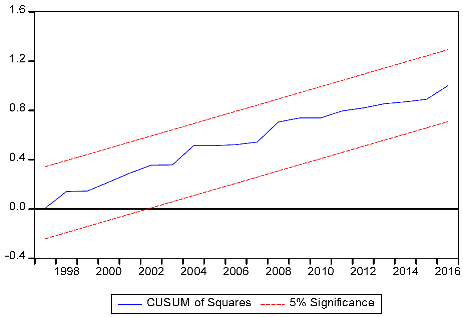 | 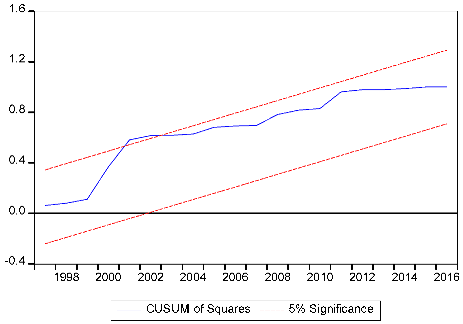 | 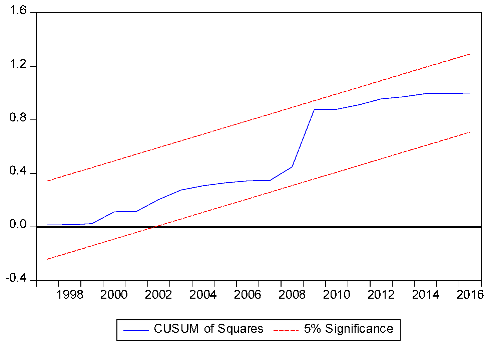 |  |
| Sig values in parentheses | ||||
Disclaimer/Publisher’s Note: The statements, opinions and data contained in all publications are solely those of the individual author(s) and contributor(s) and not of MDPI and/or the editor(s). MDPI and/or the editor(s) disclaim responsibility for any injury to people or property resulting from any ideas, methods, instructions or products referred to in the content. |
© 2023 by the authors. Licensee MDPI, Basel, Switzerland. This article is an open access article distributed under the terms and conditions of the Creative Commons Attribution (CC BY) license (https://creativecommons.org/licenses/by/4.0/).
Share and Cite
Ngarava, S.; Zhou, L.; Slayi, M.; Ningi, T.; Nguma, A.; Ncetani, N. Aquaculture Production in the Midst of GHG Emissions in South Africa. Water 2023, 15, 1253. https://doi.org/10.3390/w15071253
Ngarava S, Zhou L, Slayi M, Ningi T, Nguma A, Ncetani N. Aquaculture Production in the Midst of GHG Emissions in South Africa. Water. 2023; 15(7):1253. https://doi.org/10.3390/w15071253
Chicago/Turabian StyleNgarava, Saul, Leocadia Zhou, Mhlangabezi Slayi, Thulani Ningi, Aphiwe Nguma, and Nelisiwe Ncetani. 2023. "Aquaculture Production in the Midst of GHG Emissions in South Africa" Water 15, no. 7: 1253. https://doi.org/10.3390/w15071253
APA StyleNgarava, S., Zhou, L., Slayi, M., Ningi, T., Nguma, A., & Ncetani, N. (2023). Aquaculture Production in the Midst of GHG Emissions in South Africa. Water, 15(7), 1253. https://doi.org/10.3390/w15071253







